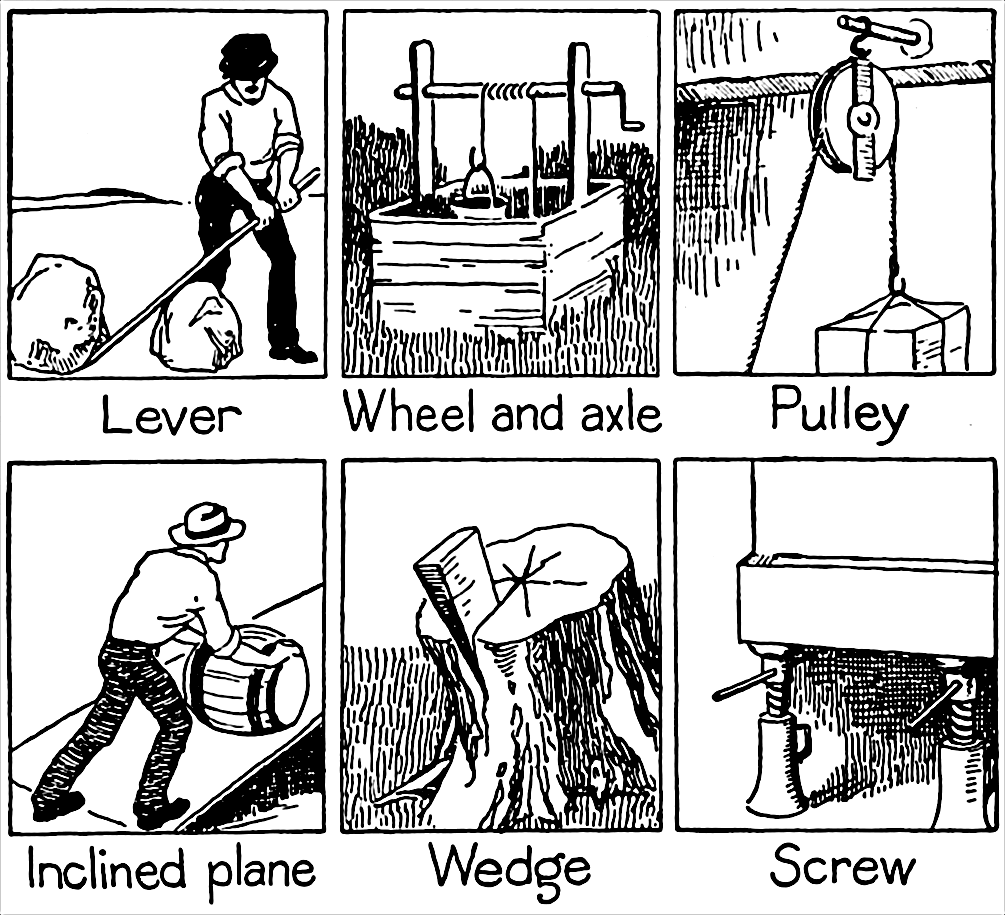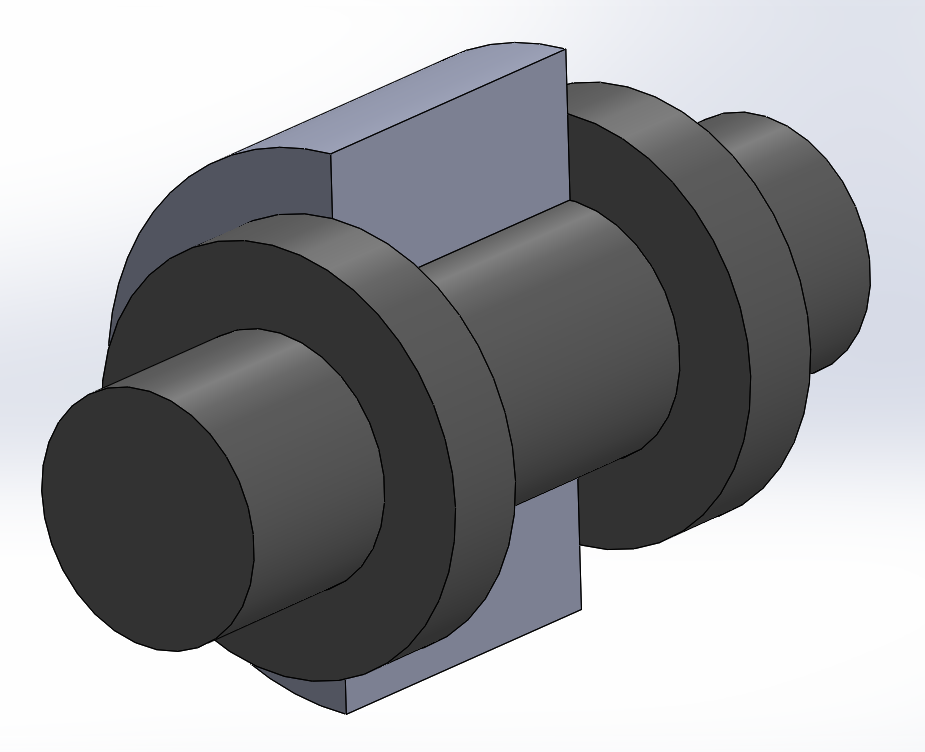|
Machines
A machine is a physical system that uses power to apply forces and control movement to perform an action. The term is commonly applied to artificial devices, such as those employing engines or motors, but also to natural biological macromolecules, such as molecular machines. Machines can be driven by animals and people, by natural forces such as wind and water, and by chemical, thermal, or electrical power, and include a system of mechanisms that shape the actuator input to achieve a specific application of output forces and movement. They can also include computers and sensors that monitor performance and plan movement, often called mechanical systems. Renaissance natural philosophers identified six simple machines which were the elementary devices that put a load into motion, and calculated the ratio of output force to input force, known today as mechanical advantage. Modern machines are complex systems that consist of structural elements, mechanisms and control compo ... [...More Info...] [...Related Items...] OR: [Wikipedia] [Google] [Baidu] |
Molecular Machine
Molecular machines are a class of molecules typically described as an assembly of a discrete number of molecular components intended to produce mechanical movements in response to specific stimuli, mimicking macromolecular devices such as switches and motors. Naturally occurring or biological molecular machines are responsible for vital living processes such as DNA replication and ATP synthesis. Kinesins and ribosomes are examples of molecular machines, and they often take the form of multi-protein complexes. For the last several decades, scientists have attempted, with varying degrees of success, to miniaturize machines found in the macroscopic world. The first example of an artificial molecular machine (AMM) was reported in 1994, featuring a rotaxane with a ring and two different possible binding sites. In 2016 the Nobel Prize in Chemistry was awarded to Jean-Pierre Sauvage, Sir J. Fraser Stoddart, and Bernard L. Feringa for the design and synthesis of molecular machine ... [...More Info...] [...Related Items...] OR: [Wikipedia] [Google] [Baidu] |
Mechanical System
A machine is a physical system that uses power to apply forces and control movement to perform an action. The term is commonly applied to artificial devices, such as those employing engines or motors, but also to natural biological macromolecules, such as molecular machines. Machines can be driven by animals and people, by natural forces such as wind and water, and by chemical, thermal, or electrical power, and include a system of mechanisms that shape the actuator input to achieve a specific application of output forces and movement. They can also include computers and sensors that monitor performance and plan movement, often called mechanical systems. Renaissance natural philosophers identified six simple machines which were the elementary devices that put a load into motion, and calculated the ratio of output force to input force, known today as mechanical advantage. Modern machines are complex systems that consist of structural elements, mechanisms and control compo ... [...More Info...] [...Related Items...] OR: [Wikipedia] [Google] [Baidu] |
Simple Machine
A simple machine is a machine, mechanical device that changes the Direction (geometry) , direction or Magnitude_(mathematics) , magnitude of a force. In general, they can be defined as the simplest Mechanism (engineering) , mechanisms that use mechanical advantage (also called leverage) to multiply force. Usually the term refers to the six classical simple machines that were defined by Renaissance scientists: * Lever * Wheel and axle * Pulley * Inclined plane * Wedge (mechanical device), Wedge * Screw (simple machine), Screw A simple machine uses a single applied force to do Mechanical work, work against a single load force. Ignoring friction losses, the work done on the load is equal to the work done by the applied force. The machine can increase the amount of the output force, at the cost of a proportional decrease in the distance moved by the load. The ratio of the output to the applied force is called the ''mechanical advantage''. Simple machines can be regarded as the eleme ... [...More Info...] [...Related Items...] OR: [Wikipedia] [Google] [Baidu] |
Robot
A robot is a machine—especially one Computer program, programmable by a computer—capable of carrying out a complex series of actions Automation, automatically. A robot can be guided by an external control device, or the robot control, control may be embedded within. Robots may be constructed to evoke Humanoid robot, human form, but most robots are task-performing machines, designed with an emphasis on stark functionality, rather than expressive aesthetics. Robots can be autonomous robot, autonomous or semi-autonomous and range from humanoids such as Honda's ''Advanced Step in Innovative Mobility'' (ASIMO) and TOSY's ''TOSY Ping Pong Playing Robot'' (TOPIO) to industrial robots, robot-assisted surgery, medical operating robots, patient assist robots, dog therapy robots, collectively programmed Swarm robotics, ''swarm'' robots, UAV drones such as General Atomics MQ-1 Predator, and even microscopic Nanorobotics, nanorobots. By mimicking a lifelike appearance or automating mo ... [...More Info...] [...Related Items...] OR: [Wikipedia] [Google] [Baidu] |
Mechanism (engineering)
In engineering, a mechanism is a Machine, device that transforms input forces and movement into a desired set of output forces and movement. Mechanisms generally consist of moving components which may include Gears and gear trains; belt drive, Belts and chain drives; Cam (mechanism), cams and cam follower, followers; Linkage (mechanical), Linkages; Friction devices, such as brakes or clutches; Structural components such as a frame, fasteners, bearings, springs, or lubricants; Various machine elements, such as splines, pins, or keys. German scientist Franz Reuleaux defines ''machine'' as "a combination of resistant bodies so arranged that by their means the mechanical forces of nature can be compelled to do work accompanied by certain determinate motion". In this context, his use of ''machine'' is generally interpreted to mean ''mechanism''. The combination of force and movement defines Power (physics), power, and a mechanism manages power to achieve a desired set of forces and ... [...More Info...] [...Related Items...] OR: [Wikipedia] [Google] [Baidu] |
Machine Tool
A machine tool is a machine for handling or machining metal or other rigid materials, usually by cutting, Boring (manufacturing), boring, grinding (abrasive cutting), grinding, shearing, or other forms of deformations. Machine tools employ some sort of tool that does the cutting or shaping. All machine tools have some means of constraining the workpiece and provide a guided movement of the parts of the machine. Thus, the relative movement between the workpiece and the cutting tool (which is called the toolpath) is controlled or constrained by the machine to at least some extent, rather than being entirely "offhand" or "wikt:freehand#Adjective, freehand". It is a power-driven metal cutting machine which assists in managing the needed relative motion between cutting tool and the job that changes the size and shape of the job material. The precise definition of the term ''machine tool'' varies among users. While all machine tools are "machines that help people to make things", not a ... [...More Info...] [...Related Items...] OR: [Wikipedia] [Google] [Baidu] |
Computers
A computer is a machine that can be programmed to automatically carry out sequences of arithmetic or logical operations ('' computation''). Modern digital electronic computers can perform generic sets of operations known as ''programs'', which enable computers to perform a wide range of tasks. The term computer system may refer to a nominally complete computer that includes the hardware, operating system, software, and peripheral equipment needed and used for full operation; or to a group of computers that are linked and function together, such as a computer network or computer cluster. A broad range of industrial and consumer products use computers as control systems, including simple special-purpose devices like microwave ovens and remote controls, and factory devices like industrial robots. Computers are at the core of general-purpose devices such as personal computers and mobile devices such as smartphones. Computers power the Internet, which links billions o ... [...More Info...] [...Related Items...] OR: [Wikipedia] [Google] [Baidu] |
Vehicle
A vehicle () is a machine designed for self-propulsion, usually to transport people, cargo, or both. The term "vehicle" typically refers to land vehicles such as human-powered land vehicle, human-powered vehicles (e.g. bicycles, tricycles, velomobiles), animal-powered transports (e.g. horse-drawn vehicle, horse-drawn carriages/wagons, ox carts, dog sleds), motor vehicles (e.g. motorcycles, cars, trucks, buses, mobility scooters) and rail transport, railed vehicles (trains, trams and monorails), but more broadly also includes cable transport (aerial lift, cable cars and elevators), watercraft (ships, boats and underwater vehicles), amphibious vehicles (e.g. screw-propelled vehicles, hovercraft, seaplanes), aircraft (airplanes, helicopters, glider (aircraft), gliders and aerostats) and space vehicles (spacecraft, spaceplanes and launch vehicles). This article primarily concerns the more ubiquitous land vehicles, which can be broadly classified by the type of contact interface with ... [...More Info...] [...Related Items...] OR: [Wikipedia] [Google] [Baidu] |
Water Power
Hydropower (from Ancient Greek -, "water"), also known as water power or water energy, is the use of falling or fast-running water to produce electricity or to power machines. This is achieved by converting the gravitational potential or kinetic energy of a water source to produce power. Hydropower is a method of sustainable energy production. Hydropower is now used principally for hydroelectric power generation, and is also applied as one half of an energy storage system known as pumped-storage hydroelectricity. Hydropower is an attractive alternative to fossil fuels as it does not directly produce carbon dioxide or other atmospheric pollutants and it provides a relatively consistent source of power. Nonetheless, it has economic, sociological, and environmental downsides and requires a sufficiently energetic source of water, such as a river or elevated lake. International institutions such as the World Bank view hydropower as a low-carbon means for economic development. S ... [...More Info...] [...Related Items...] OR: [Wikipedia] [Google] [Baidu] |
Thermal Energy
The term "thermal energy" is often used ambiguously in physics and engineering. It can denote several different physical concepts, including: * Internal energy: The energy contained within a body of matter or radiation, excluding the potential energy of the whole system. * Heat: Energy in transfer between a system and its surroundings by mechanisms other than Work (thermodynamics), thermodynamic work and transfer of matter. * The characteristic energy kT (energy), associated with a single microscopic degree of freedom, where denotes temperature and denotes the Boltzmann constant. Mark Zemansky (1970) has argued that the term "thermal energy" is best avoided due to its ambiguity. He suggests using more precise terms such as "internal energy" and "heat" to avoid confusion. The term is, however, used in some textbooks.For example: Relation between heat and internal energy In thermodynamics, heat is energy in transfer to or from a thermodynamic system by mechanisms other than t ... [...More Info...] [...Related Items...] OR: [Wikipedia] [Google] [Baidu] |
Electricity
Electricity is the set of physical phenomena associated with the presence and motion of matter possessing an electric charge. Electricity is related to magnetism, both being part of the phenomenon of electromagnetism, as described by Maxwell's equations. Common phenomena are related to electricity, including lightning, static electricity, electric heating, electric discharges and many others. The presence of either a positive or negative electric charge produces an electric field. The motion of electric charges is an electric current and produces a magnetic field. In most applications, Coulomb's law determines the force acting on an electric charge. Electric potential is the Work (physics), work done to move an electric charge from one point to another within an electric field, typically measured in volts. Electricity plays a central role in many modern technologies, serving in electric power where electric current is used to energise equipment, and in electronics dealing w ... [...More Info...] [...Related Items...] OR: [Wikipedia] [Google] [Baidu] |









